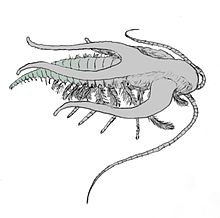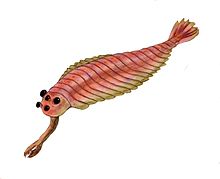Harry Blackmore Whittington
Harry Blackmore Whittington (born March 24, 1916 in Birmingham , † June 20, 2010 in Cambridge ) was a British paleontologist . He became internationally known for his studies of the fossils of the Burgess Shale and was regarded as "the world's leading authority on trilobites ."
Life
Harry Whittington grew up in Birmingham, where he attended Handsworth grammar school and acquired in 1937 at the University of Birmingham his doctorate with a thesis on the geology of the Berwyn Hills in the north of Wales , where he, the age of the rock with the help of brachiopods and trilobites certain . In 1938, thanks to a grant (Commonwealth Fellowship), he came to the Peabody Museum of Natural History at Yale University in New Haven , Connecticut , where he also carried out research on certain trilobites from the Ordovician (Trinucleidea). Two years later he took on a teaching position as a lecturer in Rangoon (then Burma ), which he soon had to give up , shortly before the occupation of Burma by Japanese troops in 1942 . He succeeded in emigrating to China and until 1945 in Chengdu as a teacher at Ginling Women's College to secure his living.
After the end of the fighting in Europe Whittington returned to Birmingham and in 1945 initially received a position as a lecturer. In the vicinity of the northern Welsh town of Bala , he continued his geological-palaeontological studies on rocks of the Ordovician and the silicified trilobites (fossils in which the organic material was "replaced" by silicon compounds) contained in them . In 1949 he moved to the Museum of Comparative Zoology at Harvard University in Cambridge (US state Massachusetts ), for which he worked for the following 16 years. In 1966 he took over the leadership of a research team of the Geological Survey of Canada , which investigated the fossils of the Burgess Shale (Burgess Shale) in the Canadian Rocky Mountains and moved in the same year to the University of Cambridge , where he was last Woodwardian Professor of Geology; his successor at Harvard was Stephen Jay Gould . It was only through Whittington's research that the importance of this site became known internationally in the professional world.
Harry Whittington was married to Dorothy Arnold from 1940 to 1997. The couple had no children. In 2002 they both founded the HB and Dorothy A. Whittington Fund to promote paleontological research at Cambridge University.
Research topics
After Whittington went to the USA from England in 1949 , he studied in particular the individual development of trilobites using fossilized larvae , juvenile stages and adult specimens from Virginia , Newfoundland and North Wales. In the following 16 years he established himself "as the international authority on trilobites". Since the youth stages were often less than a millimeter long, he had to develop new photographic methods - in a time before the invention of scanning electron microscopy - to illustrate his publications comprehensibly and to document the microfossils . His work provided important insights into the morphology and evolution of trilobites; Furthermore, first insights into the composition of some communities of the Ordovician, some of which reached across tectonic plates that are far away today , from which conclusions can be drawn about the drift of the tectonic plates .
Whittington's most important contribution to scientific research are his studies on Burgess slate. Although this fossil deposit was discovered and described by Charles Walcott in 1909 , it remained largely unnoticed afterwards. It was not until the new field studies led by Whittington in 1966 that their importance for the understanding of the so-called Cambrian explosion was recognized internationally.
One of the first animals Whittington examined closely was Marrella , the most common genus of that epoch, which, however, belonged neither to the trilobites nor to the Cheliceraten nor to the Crustacea . His working group developed numerous new methods to be able to deduce their original, three-dimensional appearance from the fossils flattened in the rock. Among other things, a reconstruction of the five-eyed Opabinia with its unique "trunk" and rudder-like tail was created in 1972, which was initially ridiculed but later accepted .
In 1985 Whittington summarized the knowledge gained up to that point about the early evolution of animal phyla in his specialist book The Burgess Shale , which, however, received little attention outside the specialist world. It was only after Stephen Jay Gould published his popular scientific book Wonderful Life: The Burgess Shale and the Nature of History four years later , in which he presented the bizarre findings of the fossil deposit in detail, that the Burgess slate also came into the focus of scientific laypeople.
A leading trilobite expert, he was the editor of the Treatise on Invertebrate Paleontology Trilobite Volume .
In 1953 Whittington was elected to the American Academy of Arts and Sciences .
Awards
Harry Whittington received the International Biology Prize in 2001 and the Wollaston Medal in the same year . In 2000 he received the Lapworth Medal of the Palaeontological Association , of which he is an honorary member.
literature
- Harry B. Whittington: The Burgess Shale. Yale University Press, 1985, ISBN 978-0300033489
- Stephen Jay Gould : Chance Man. The miracle of life as a game of nature. dtv, 1994, ISBN 978-3423303897 (= German paperback edition of Wonderful Life: The Burgess Shale and the Nature of History )
Web links
- Smithsonian Institution website of the Burgess Shale Fossils
- Localities of the Cambrian: The Burgess Shale. At: berkeley.edu , accessed April 1, 2015
Individual evidence
- ↑ a b Derek EG Briggs: Obituary: Harry Whittington (1916-2010). In: Nature , Volume 466, 2010, p. 706, doi : 10.1038 / 466706a
- ^ According to Richard Fortey in an obituary in The Guardian of July 8, 2010: Harry Whittington obituary: Palaeontologist who advanced knowledge of the origins of animal diversity. Full text
- ↑ Chris Mair: Obituary: Harry Whittington, palaeontologist. In: The Scotsman full text
- ^ University of Cambridge : Graces submitted to the Regent House on July 17, 2002.
- ^ Members of the American Academy. Listed by election year, 1950-1999 ( [1] ). Retrieved September 23, 2015
| personal data | |
|---|---|
| SURNAME | Whittington, Harry Blackmore |
| BRIEF DESCRIPTION | British paleontologist |
| DATE OF BIRTH | March 24, 1916 |
| PLACE OF BIRTH | Birmingham |
| DATE OF DEATH | June 20, 2010 |
| Place of death | Cambridge |

